Risk Assessment of Community-Scale High-Temperature and Rainstorm Waterlogging Disasters: A Case Study of the Dongsi Community in Beijing
Abstract
1. Introduction
2. Materials and Methods
2.1. Overview of the Study Area
2.2. Data Information
2.3. Research Methods
3. Results
3.1. Characteristics of the Refined Community Risk Assessment Indicators
3.1.1. Characteristics of Meteorological Assessment Indicators
3.1.2. Characteristics of Other Nonmeteorological Assessment Indicators
3.2. Risk Assessment of Community High-Temperature Disasters
3.3. Risk Assessment of Community Rainstorm Waterlogging Disasters
4. Discussion
4.1. Necessity of Conducting Community-Scale Risk Assessment
4.2. Limitations and Prospects
5. Conclusions
Author Contributions
Funding
Institutional Review Board Statement
Informed Consent Statement
Data Availability Statement
Conflicts of Interest
References
- Li, C.; Lu, T.; Fu, B.; Wang, S.; Holden, J. Sustainable city development challenged by extreme weather in a warming world. Geogr. Sustain. 2022, 3, 114–118. [Google Scholar] [CrossRef]
- IPCC (Intergovernmental Panel on Climate Change). Climate Change 2022: Impacts, Adaptation, and Vulnerability; Cambridge University Press: Cambridge, UK, 2022; Available online: https://www.ipcc.ch/report/ar6/wg2/ (accessed on 12 August 2022).
- Chan, F.K.S.; Yang, L.E.; Scheffran, J.; Mitchell, G.; Mcdonald, A. Urban flood risks and emerging challenges in a Chinese delta: The case of the Pearl River Delta. Environ. Sci. Policy 2021, 122, 101–115. [Google Scholar] [CrossRef]
- Hemmati, M.; Kornhuber, K.; Kruczkiewicz, A. Enhanced urban adaptation efforts needed to counter rising extreme rainfall risks. NPJ Urban Sustain. 2022, 2, 16. [Google Scholar] [CrossRef]
- Ouyang, H.; Tang, X.; Zhang, R.; Baklanov, A.; Brasseur, G.; Kumar, R.; Han, Q.; Luo, Y. Resilience building and collaborative governance for climate change adaptation in response to a new state of more frequent and intense extreme weather events. Int. J. Disast. Risk Sc. 2023, 14, 162–169. [Google Scholar] [CrossRef]
- Shan, Z.; An, Y.; Xu, L.; Yuan, M. High-temperature disaster risk Assessment for Urban Communities: A Case Study in Wuhan, China. Int. J. Environ. Res. Public Health 2022, 19, 183. [Google Scholar] [CrossRef] [PubMed]
- WMO (World Meteorological Organization). United in Science 2022: A Multi-Organization High-Level Compilation of the Most Recent Science Related to Climate Change, Impacts and Responses. Available online: https://wmo.int/publication-series/united-science-2022 (accessed on 23 January 2023).
- Olazabal, M.; Gopegui, M.R.D. Adaptation planning in large cities is unlikely to be effective. Landsc. Urban Plan. 2021, 206, 103974. [Google Scholar] [CrossRef]
- Liu, J.; Shen, Y. Research on community resilience oriented to risk governance. Urban Dev. Stud. 2017, 24, 83–91. [Google Scholar] [CrossRef]
- Peng, C.; Guo, Z.; Peng, Z. Research progress on the theory and practice of foreign community resilience. Urban Plan. Int. 2017, 32, 60–66. [Google Scholar] [CrossRef]
- Yang, L.; Chen, W.; Wu, J.; Sun, W.; Li, Y. Spatial planning adapting to climate change: Progress in the content and methodology. Urban Plan. Int. 2020, 35, 96–100+3701–3703. [Google Scholar] [CrossRef]
- Kong, D.; Gu, X.; Li, J.; Ren, G.; Liu, J. Contributions of global warming and urbanization to the intensification of human-perceived heatwaves over China. J. Geophys. Res. Atmos. 2020, 125, e2019JD032175. [Google Scholar] [CrossRef]
- Zheng, Y.; Wang, M.; Li, J.; Xia, D. Risk assessment of high temperature and adaptive planning strategies: Shenzhen example. Planners 2021, 37, 13–19. [Google Scholar]
- Leis, J.L.; Kienberger, S. Climate risk and vulnerability assessment of floods in Austria: Mapping homogenous regions, hotspots and typologies. Sustainability 2020, 12, 6458. [Google Scholar] [CrossRef]
- Chen, K.; Tang, Y. Identification of urban areas vulnerable to heat waves and coping strategies: A case study of Beijing central city. City Plan. Rev. 2019, 43, 37–44. [Google Scholar]
- Jiang, T.; Wang, Y.; Su, B. Meteorological Disaster Risk Assessment and Management; Science Press: Beijing, China, 2023; pp. 12–15. [Google Scholar]
- Cheng, C.; Fang, X.; Li, M.; Yang, Y.; Gao, Y.; Zhang, S.; Yu, Y.; Liu, Y.; Du, W. Rainstorm and high-temperature disaster risk assessment of territorial space in Beijing, China. Meteorol. Appl. 2023, 30, e2140. [Google Scholar] [CrossRef]
- Wang, Y.; Zhai, J.; Gao, G.; Liu, Q.; Song, L. Risk assessment of rainstorm disasters in the Guangdong–Hong Kong–Macao greater Bay area of China during 1990–2018. Geomat. Nat. Haz. Risk 2022, 13, 267–288. [Google Scholar] [CrossRef]
- Zhao, K.; Wang, J.; Yan, Q.; Huang, X. Urban waterlogging simulation and its risk assessment in the old area of Xi’an. J. Nat. Disasters 2023, 32, 1–12. [Google Scholar] [CrossRef]
- Jiang, T.; Wang, Y.; Zhai, J. Technical Guide for Meteorological Disaster Risk Assessment; China Meteorological Press: Beijing, China, 2018; pp. 135–138. [Google Scholar]
- Li, J.; Xu, X.; Yang, J.; Liu, Z. Ambient high temperature and mortality in Jinan, China: A study of heat thresholds and vulnerable populations. Environ. Res. 2017, 156, 657–664. [Google Scholar] [CrossRef]
- Krstic, N.; Yuchi, W.; Ho, H.C.; Walker, B.B.; Knudby, A.J.; Henderson, S.B. The heat exposure integrated deprivation index (HEIDI): A data-driven approach to quantifying neighborhood risk during extreme hot weather. Environ. Int. 2017, 109, 42–52. [Google Scholar] [CrossRef]
- Li, W.; Xu, B.; Wen, J. Scenario-based community flood risk assessment: A case study of Taining county town, Fujian province, China. Nat. Hazards 2016, 82, 193–208. [Google Scholar] [CrossRef]
- Liu, F.; Liu, X.; Xu, T.; Yang, G.; Zhao, Y. Driving factors and risk assessment of rainstorm waterlogging in urban agglomeration areas: A case study of the Guangdong-Hong Kong-Macao greater Bay Area, China. Water 2021, 13, 770. [Google Scholar] [CrossRef]
- Uejio, C.K.; Wilhelmi, O.V.; Golden, J.S.; Mills, D.M.; Gulino, S.P.; Samenow, J.P. Intra-urban societal vulnerability to extreme heat: The role of heat exposure and the built environment, socioeconomics, and neighborhood stability. Health Place 2011, 17, 498–507. [Google Scholar] [CrossRef] [PubMed]
- Xiao, H.; Guo, Y.; Wang, Y.; Xu, Y.; Shi, J. Mitigation and adaptation approach in neighborhood scale to cope with health risks under extreme heat stress: Experience and implications of cool neighborhoods NYC. Planners 2022, 38, 151–158. [Google Scholar]
- Xuan, C.; Liu, Y.; Yang, X.; Shu, W.; Wu, C.; Hu, Y.; Du, W. Risk zoning of Beijing rainstorm disasters based on 1 km resolution grids. Meteorol. Sci. Technol. 2020, 48, 579–589. [Google Scholar] [CrossRef]
- Song, L. Climate risk and adaptation strategies in metropolis dense areas: A case study of Shanghai. China Popul. Resour. Environ. 2012, 22, 6–12. [Google Scholar]
- Zhu, C.; Liu, M.; Xu, J. The development strategy of Boston’s climate resilient city and its implications. Innov. Sci. Technol. 2021, 21, 29–37. [Google Scholar] [CrossRef]
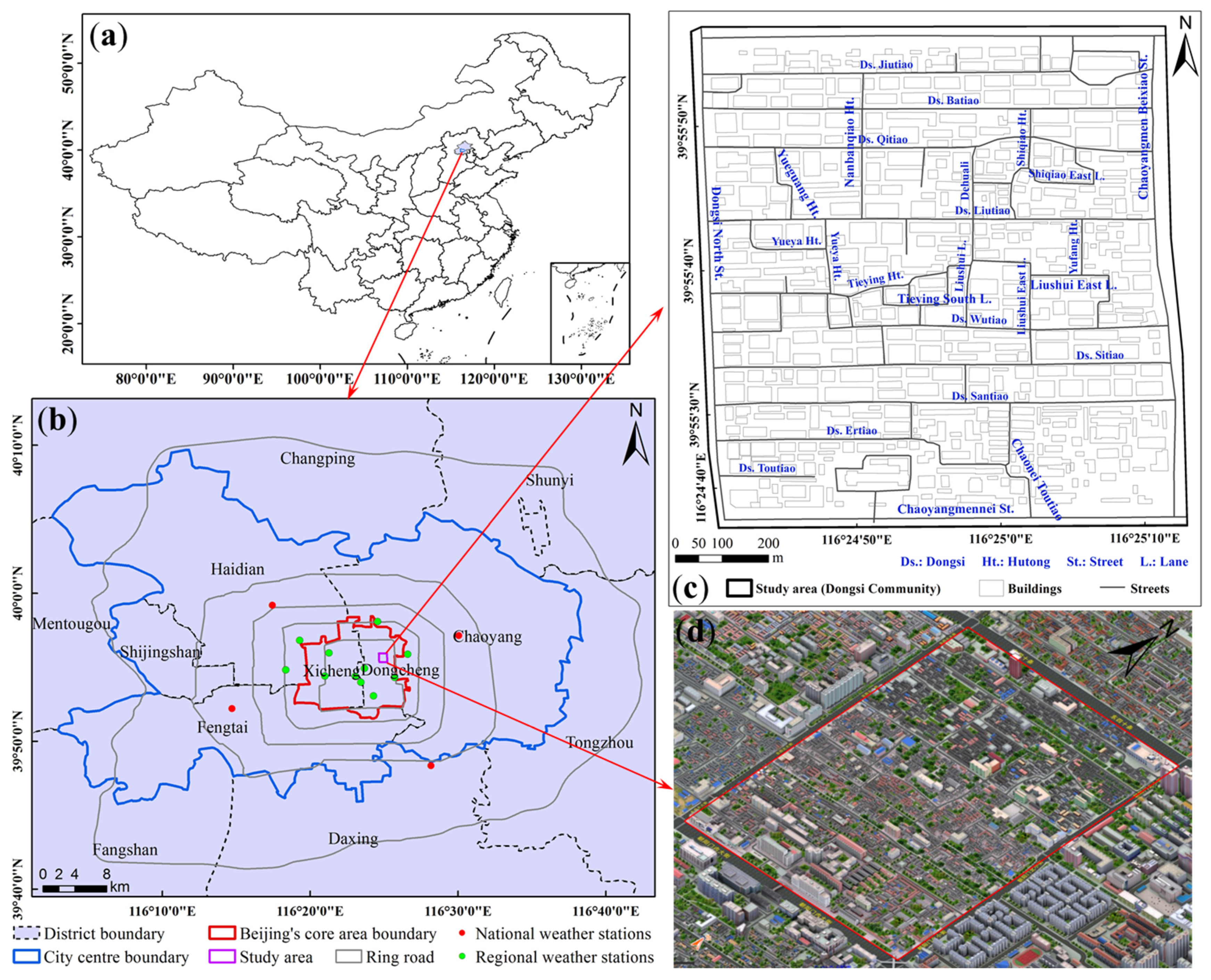
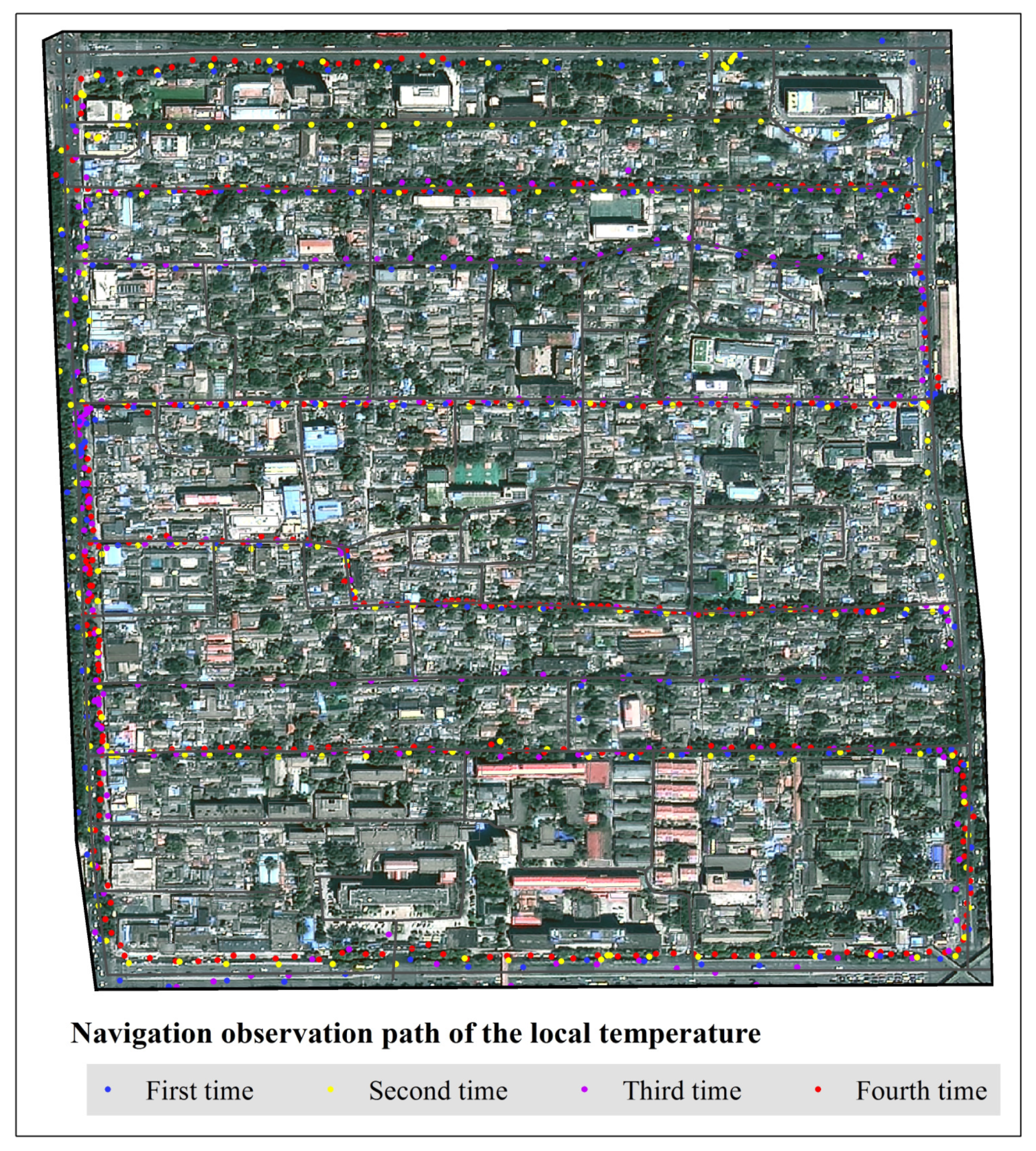
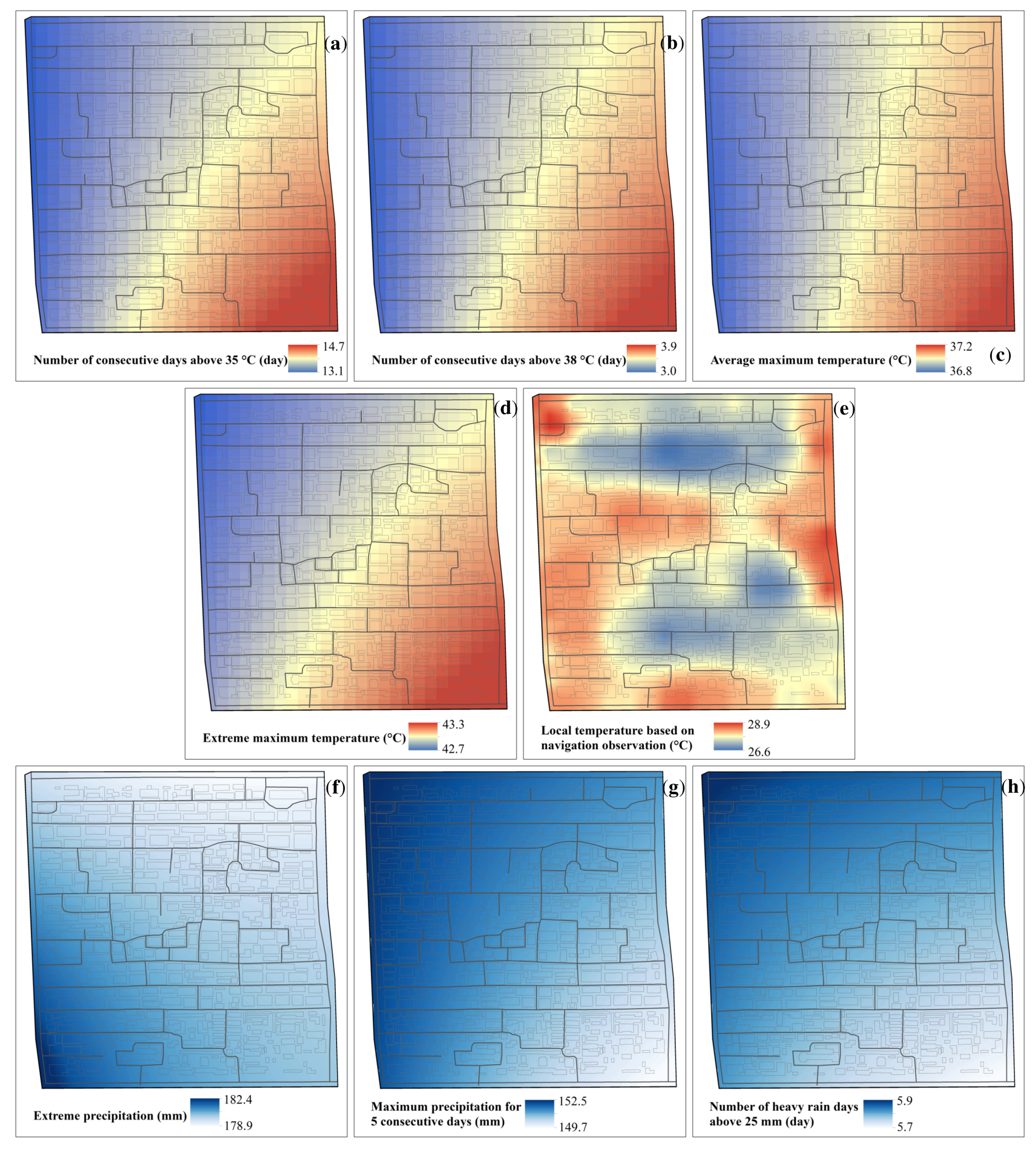
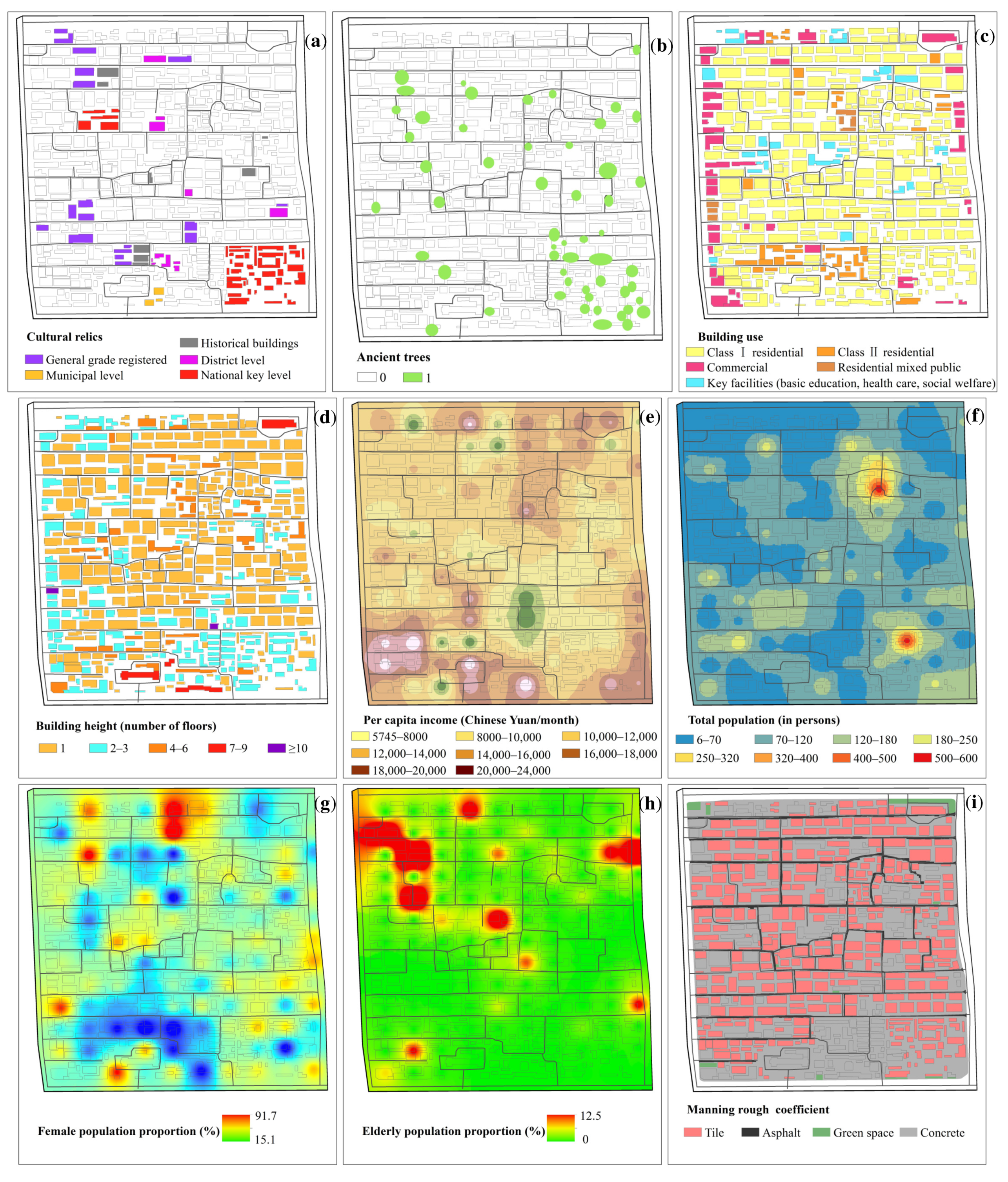
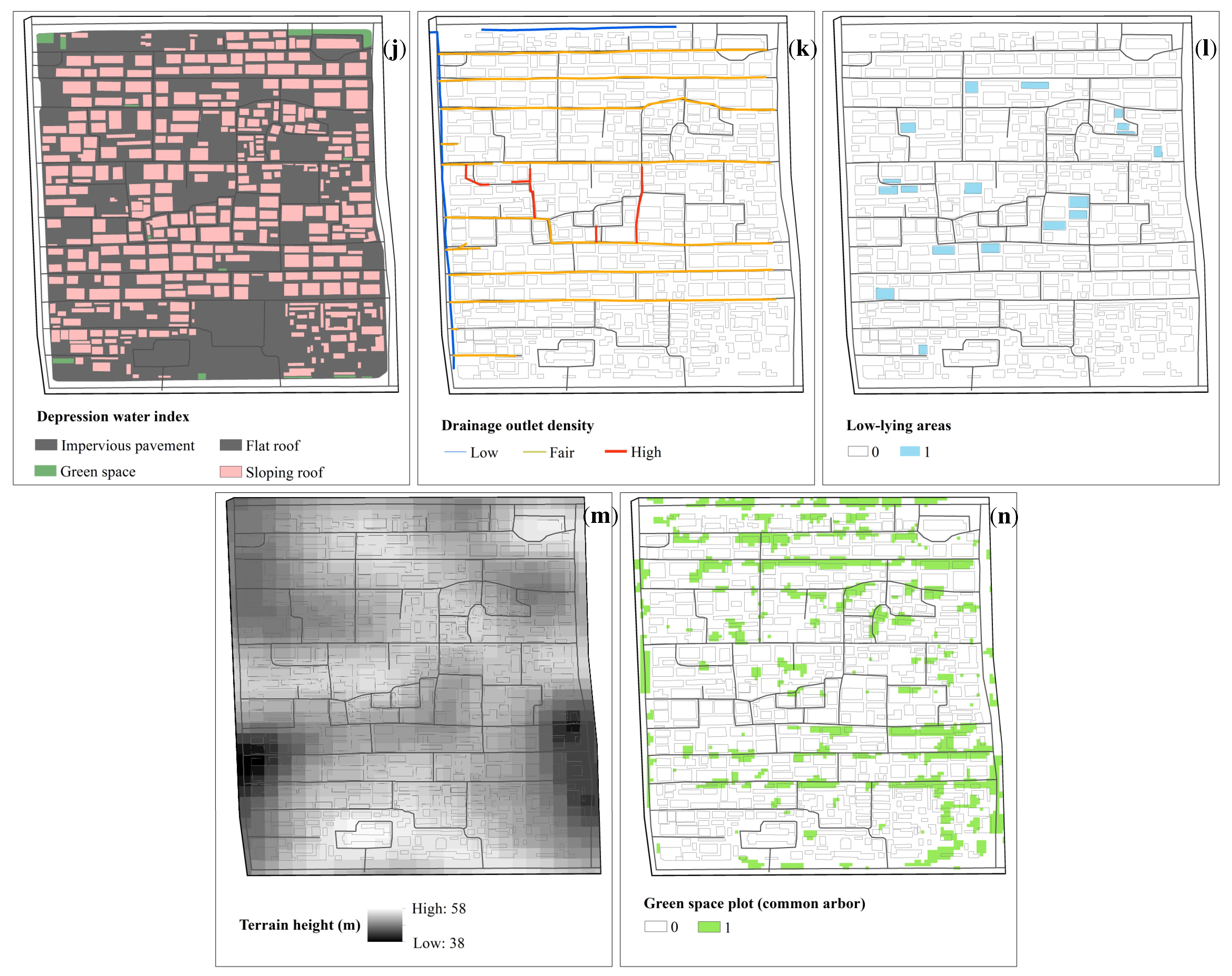
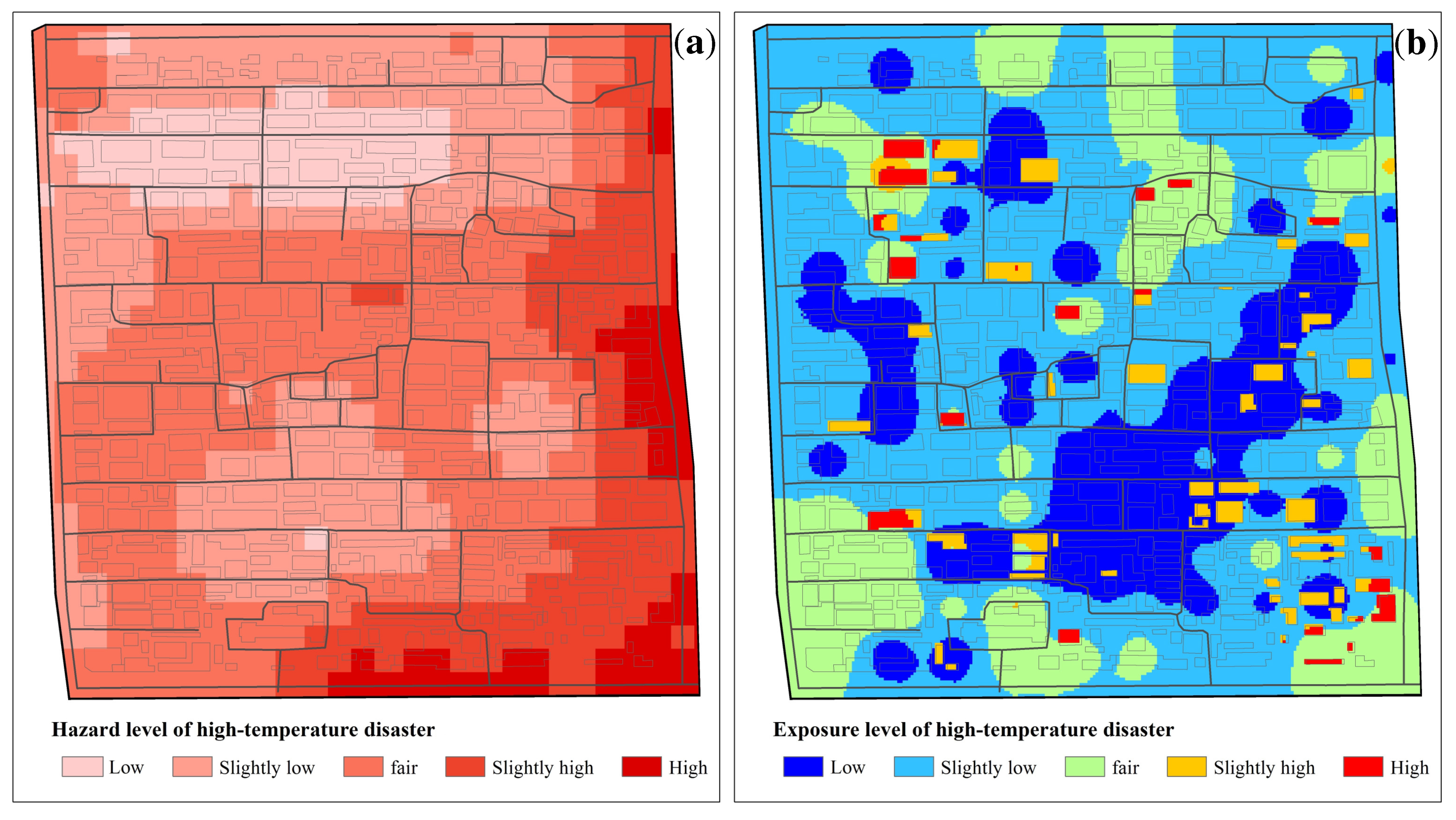
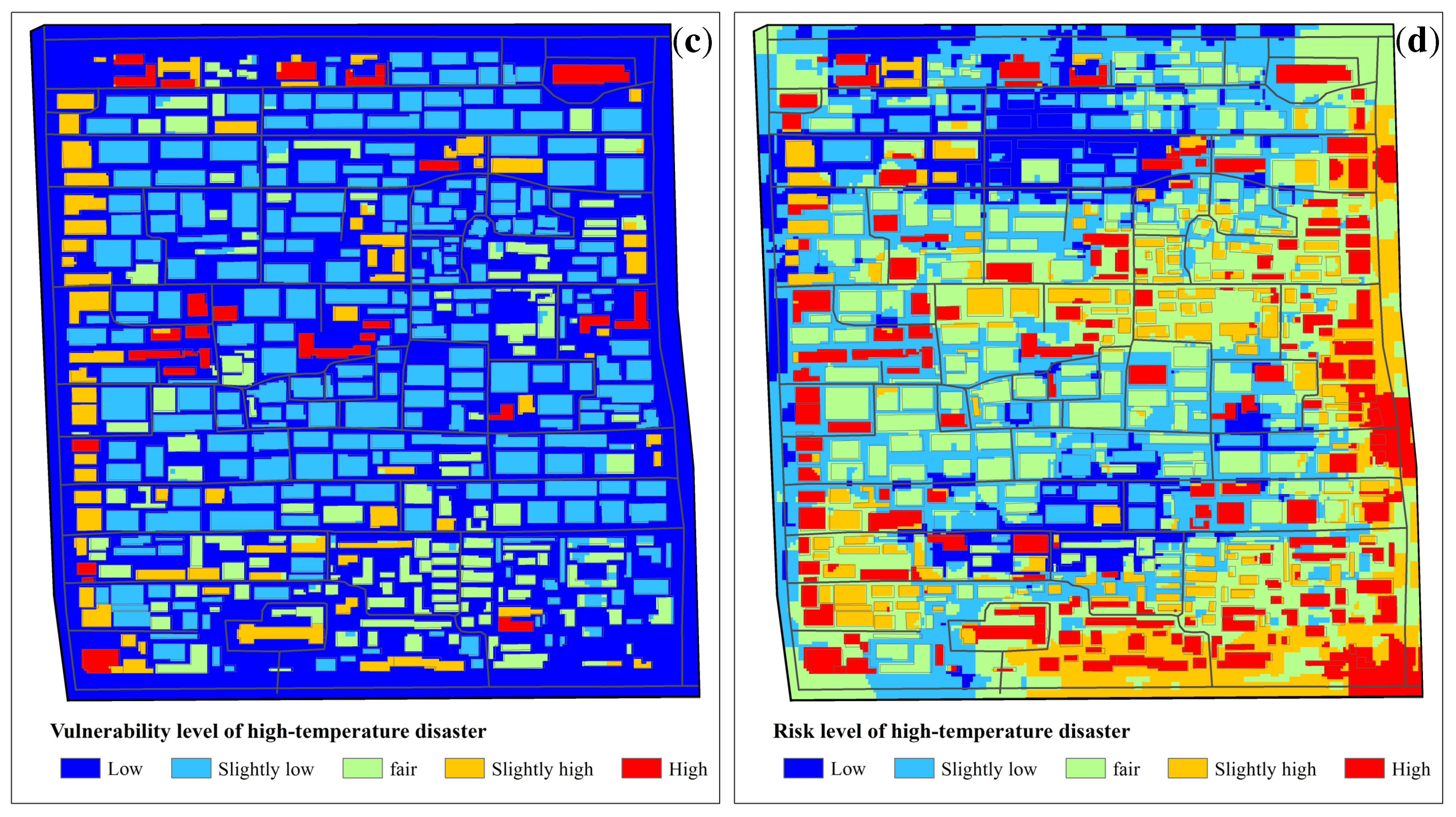

| Data Type | Data Characteristics and Sources |
|---|---|
| Temperature and precipitation data | Meteorological observation station data from Beijing Meteorological Data Center for the period 2012–2020. |
| Local temperature in the community | Sourced from navigation observations on 25 August 2021, late afternoon; 26 August 2021, evening; 30 August 2021, late afternoon; and 1 September 2021, morning. |
| Range, building, street, drainage network vector data | The information on the scope of the study area, building height, building type, distribution of historical and cultural heritage, road grade, locations and diameters of drainage pipes were sourced from the “Regulation Rules and Explanation Guidelines for Dongsi Street”, dated 2020. |
| Land use data | Based on Landsat satellite remote sensing retrieval, with a spatial resolution of 10 m, dated 2020. |
| DEM data | SRTM DEM terrain data with a spatial resolution of 30 m released by the National Aeronautics and Space Administration (NASA) (https://dwtkns.com/srtm30m/ or https://earthexplorer.usgs.gov/, both accessd on 9 January 2022). |
| Population and per capita income data | Accuracy of 70 m × 80 m, from Baidu Huiyan resident population data in 2020 (https://huiyan.baidu.com/, accessed on 25 November 2021). The data introduction states that all stages of data processing are anonymized, and each stage and output do not involve individual privacy. |
| Distribution data of courtyards with low-lying ponded water | Sourced from the Dongsi Street Office in 2021. |
| Surface roughness coefficient and depression water storage index | The surface type was determined based on the land use, and the coefficient and index values were queried in the “Storm Water Management Model (SWMMH) User’s Manual (version 5.0)”. |
| Primary Indicators and Weights | Secondary Indicators and Weights | ||||
|---|---|---|---|---|---|
| Primary Indicators | Weight Coefficient | Type | Secondary Indicators | Weight Coefficient | Role |
| Hazard | 0.30 | Observed temperature from meteorological stations | Extreme maximum temperature | 0.20 | + |
| Average maximum temperature | 0.15 | + | |||
| Number of consecutive days above 35 °C | 0.05 | + | |||
| Number of consecutive days above 38 °C | 0.10 | + | |||
| Navigation observation of local temperature | Local temperature in community | 0.50 | + | ||
| Exposure | 0.40 | Historical and cultural heritage related | Ancient tree | 0.21 | + |
| Historic building | 0.21 | + | |||
| Demographic related | Total population | 0.07 | + | ||
| Proportion of female population | 0.13 | + | |||
| Proportion of ≥65 year old population | 0.19 | + | |||
| Economic value | Per capita income | 0.19 | + | ||
| Vulnerability | 0.30 | Construction related | Key facilities | 0.30 | + |
| Construction use | 0.28 | + | |||
| Building height | 0.28 | + | |||
| Green space | Common trees | 0.14 | − | ||
| Primary Indicators and Weights | Secondary Indicators and Weights | ||||
|---|---|---|---|---|---|
| Primary Indicators | Weight Coefficient | Type | Secondary Indicators | Weight Coefficient | Role |
| Hazard | 0.20 | Related to precipitation element | Extreme precipitation | 0.20 | + |
| Maximum precipitation for 5 consecutive days | 0.31 | + | |||
| Number of rainstorm days | 0.49 | + | |||
| Exposure | 0.40 | Construction related | Key facilities | 0.10 | + |
| Construction use | 0.26 | + | |||
| Building height | 0.06 | + | |||
| Demographic related | Total population | 0.07 | + | ||
| Proportion of female population | 0.13 | + | |||
| Proportion of ≥65 year old population | 0.19 | + | |||
| Economic value | Per capita income | 0.19 | + | ||
| Vulnerability | 0.40 | Manning rough coefficient | Manning roughness coefficient of tile, asphalt and concrete | 0.20 | + |
| Green space Manning coefficient | 0.04 | + | |||
| Depression water storage index | Water accumulation in impervious pavement and flat roof depressions | 0.16 | + | ||
| Water accumulation in depressions on sloping roof | 0.12 | + | |||
| Water accumulation in green space depressions | 0.03 | + | |||
| Low-lying areas | Low-lying courtyard | 0.17 | + | ||
| Drainage index | Drain nozzle density | 0.08 | − | ||
| Terrain influence | DEM elevation | 0.16 | − | ||
| Green space | Common trees | 0.04 | − | ||
Disclaimer/Publisher’s Note: The statements, opinions and data contained in all publications are solely those of the individual author(s) and contributor(s) and not of MDPI and/or the editor(s). MDPI and/or the editor(s) disclaim responsibility for any injury to people or property resulting from any ideas, methods, instructions or products referred to in the content. |
© 2024 by the authors. Licensee MDPI, Basel, Switzerland. This article is an open access article distributed under the terms and conditions of the Creative Commons Attribution (CC BY) license (https://creativecommons.org/licenses/by/4.0/).
Share and Cite
Xing, P.; Yang, R.; Du, W.; Gao, Y.; Xuan, C.; Zhang, J.; Wang, J.; Bai, M.; Dang, B.; Xiong, F. Risk Assessment of Community-Scale High-Temperature and Rainstorm Waterlogging Disasters: A Case Study of the Dongsi Community in Beijing. Atmosphere 2024, 15, 1132. https://doi.org/10.3390/atmos15091132
Xing P, Yang R, Du W, Gao Y, Xuan C, Zhang J, Wang J, Bai M, Dang B, Xiong F. Risk Assessment of Community-Scale High-Temperature and Rainstorm Waterlogging Disasters: A Case Study of the Dongsi Community in Beijing. Atmosphere. 2024; 15(9):1132. https://doi.org/10.3390/atmos15091132
Chicago/Turabian StyleXing, Pei, Ruozi Yang, Wupeng Du, Ya Gao, Chunyi Xuan, Jiayi Zhang, Jun Wang, Mengxin Bai, Bing Dang, and Feilin Xiong. 2024. "Risk Assessment of Community-Scale High-Temperature and Rainstorm Waterlogging Disasters: A Case Study of the Dongsi Community in Beijing" Atmosphere 15, no. 9: 1132. https://doi.org/10.3390/atmos15091132
APA StyleXing, P., Yang, R., Du, W., Gao, Y., Xuan, C., Zhang, J., Wang, J., Bai, M., Dang, B., & Xiong, F. (2024). Risk Assessment of Community-Scale High-Temperature and Rainstorm Waterlogging Disasters: A Case Study of the Dongsi Community in Beijing. Atmosphere, 15(9), 1132. https://doi.org/10.3390/atmos15091132







